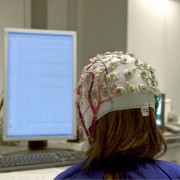By Jody Smith March 16, 2011 - 9:08am
 A pilot study involving a non-invasive test to evaluate autism risk in infants had an 80 percent accuracy rate in identifying those infants at high risk. This test uses the electroencephalogram (EEG) in conjunction with machine-learning algorithms. The algorithms discern patterns in the EEG results that might otherwise be missed.
A pilot study involving a non-invasive test to evaluate autism risk in infants had an 80 percent accuracy rate in identifying those infants at high risk. This test uses the electroencephalogram (EEG) in conjunction with machine-learning algorithms. The algorithms discern patterns in the EEG results that might otherwise be missed.This study was done at Children's Hospital Boston. The research was published on February 22, 2011 online in the journal BMC Medicine.
Brain waves are the electrical activity of the brain. EEGs can record this activity through the use of electrodes that have been attached to the child's head. For a long time, EEG tests have been used to identify those children with epilepsy, and who also have autism. Children with autism display a higher rate of epilepsy than the rest of the population.
EEGs can be useful in detecting the differences between the brain waves of children who have autism, and those who do not. So EEGs are no longer just used to assess seizure activity in epileptics, they can now also be used to detect the differences between the two types of brain waves.
Read the full article here.
No comments:
Post a Comment